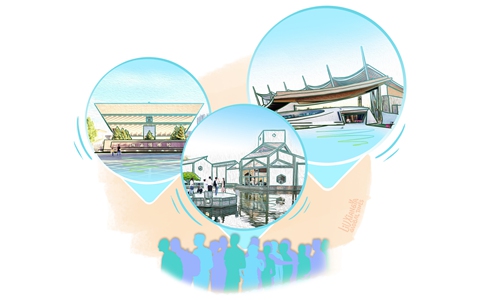
Illustration: Liu Xiangya/GT
As museums across China are continuously setting new records for visitor numbers,
mk the Grand Canal Museum of Beijing received over 33,000 visits a day recently.
From Tang poetry-themed night tours in Yangzhou, East China's Jiangsu Province, to the immersive dance drama
The Song of the Pipain East China's Jiangxi Province, and the intangible cultural heritage performances in Central China's Hunan Province, the diverse cultural events during this summer have ignited the public's enthusiasm for traditional culture.
Since the beginning of summer vacation, museums and cultural institutions across China have been bustling with activity and excitement. This "museum craze" not only showcases the profound heritage and strong appeal of Chinese culture but also reflects the growing confidence and recognition of cultural heritage among young Chinese people.
The rise of this "museum boom" also reveals that traditional tourism can no longer meet the public's growing cultural needs. Whether it's the re-creation of Tang poetry scenes during night tours or the in-depth exploration of historical culture in immersive performances, these activities have greatly enriched the cultural experience of visitors. Tourism is no longer just sightseeing tours through scenic landscapes; it has become a cultural journey through history and space.
As the nation steps up efforts in cultural heritage protection and the integration of culture and tourism deepens, museums and other cultural venues are gradually becoming important places for the public to relax, entertain, and learn new knowledge.
In response to the surge in museum visits, popular museums are encouraged to extend opening hours, organize virtual exhibitions, education courses, and live streams, and offer mobile exhibits to better meet public demand, according to a circular for enhancing museum services released by the National Cultural Heritage Administration (NCHA) in early July.
Many museums across the country have also lifted reservation requirements recently, fueling the surge in visitor numbers.
The Chinese government has expanded the number of ports adopting the 144-hour visa-free transit policy to 37, embracing guests from around the globe. The number of foreigners visiting China in the first half of this year increased by 152.7 percent compared with the same period of 2023.
In addition to extending working hours, museums have integrated cultural resources with technological innovation to enrich the general public's experiences.
The immersive performance
The Song of the Pipacombines modern stage technology with stories about history, bringing new life to traditional culture in a contemporary context.
Meanwhile, in Southwest China's Sichuan Province, the Sichuan Museum's VR immersive experience exhibition uses digital technology to allow the ancient Sanxingdui civilization to transcend the boundaries of time and space and engage in a dialogue with modern audiences that spans millennia. This innovative method of cultural transmission not only showcases cultural heritage but also sparks the public's strong interest and desire to explore traditional culture.
Tourism and culture have thrived in a complimentary development model during the ongoing museum craze. On one hand, tourism serves as a medium through which traditional culture can be more widely disseminated and preserved. On the other hand, the infusion of culture injects new vitality and momentum into the development of the tourism industry. This win-win development model helps enhance the quality and competitiveness of the tourism sector while promoting the innovative development of China's traditional culture.
Moreover, the museum boom mirrors the growing confidence and recognition of cultural heritage among the younger generation. With the improvement of facilities and services at cultural institutions, more and more young people are choosing to visit museums and participate in cultural activities during the holidays, leading to a stronger sense of identity and cultural confidence in traditional culture.
Based on the latest data released by NCHA in May, as of 2023, China had 6,833 museums, with annual visits exceeding 1.2 billion.
However, behind the museum boom, there are still some issues to be addressed. The distribution of cultural resources needs to be balanced between urban and rural areas which often lack sufficient cultural resources. Utilizing modern technology and creative design to bring cultural relics to life and attract more young people's attention is another challenge.
The "museum boom" is not only a highlight of the current consumer market but also an example of the synergy between cultural preservation and tourism development. As technology and culture continue to integrate and innovate, this path of mutual benefit will widen, contributing even more to the preservation and development of China's traditional culture.
By protecting and passing on cultural heritage while continuously innovating and enhancing cultural products and services, more people worldwide can experience the unique charm of Chinese culture. This, in turn, contributes to fostering cultural confidence and national rejuvenation.
The author is a reporter with the Global Times. [email protected]

